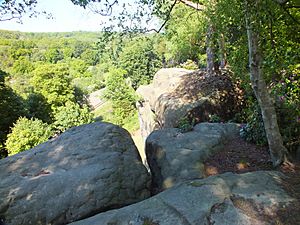High Rocks facts for kids
| Site of Special Scientific Interest | |
 |
|
| Area of Search | East Sussex Kent |
|---|---|
| Interest | Geological |
| Area | 3.2 hectares (7.9 acres) |
| Notification | 1986 |
| Location map | Magic Map |
High Rocks is a really cool place near Tunbridge Wells in East Sussex and Kent. It's a special area, about 3.2 hectares (that's like 8 acres!), because of its amazing rocks and how they were formed. It's officially called a Site of Special Scientific Interest, which means it's protected for its unique geology.
Contents
Ancient Times at High Rocks
How the Rocks Were Formed
Long, long ago, after the last ice age ended, a huge sheet of ice started to melt. As it melted, it uncovered the land where High Rocks is today. This area used to be part of a big lake called the Wealden Lake. Over time, soft mud and silt settled at the bottom of this lake. When the ice melted, these layers of silt became hard rock.
Early People and a Fort
People have lived around High Rocks for a very long time! We know this because experts have found signs of people from the Middle Stone Age and the Iron Age. There was even a fort built here around the 1st century A.D. This fort was used to protect against the Roman invasion of Britain.
High Rocks Through the Years
Becoming a Tourist Spot
In the 1600s, King James II visited nearby Tunbridge Wells and helped make it a popular holiday spot. Because of this, High Rocks also became a fun place for tourists to visit. It wasn't just about the rocks; there was a maze, a bowling alley, rooms for games, and even cold baths!
The Aerial Walk and the Railway
In the 1800s, something exciting was added: the Aerial Walk. This was a series of bridges that connected the tops of the tall rock cliffs, letting people walk high above the ground.
Later, in 1907, a small train stop was built near High Rocks. People used this train stop until 1952. Today, a special old train called the Spa Valley Railway still runs past High Rocks. You can even catch this train from the High Rocks pub to places like Tunbridge Wells, Groombridge, and Eridge.
The Amazing Geology of High Rocks
What Makes the Rocks Special
High Rocks is famous for its unique sandstone cliffs. These are the tallest cliffs in the Weald area. The rocks here are called Ardingly Sandstone. Over time, the rocks have moved slightly, causing cracks to form. These cracks are called "gulls," and some are wide enough for a person to walk inside!
Rare Cracks and Patterns
Finding open gulls like these is quite rare in Britain, except in the middle of the Weald. High Rocks is one of the best places to see them. The Ardingly Sandstone is quite crumbly and not very strong, but its surface has a special protective layer. This layer shows off many cool patterns, like "honeycombing" (lots of small holes) and "polygonal cracking" (cracks that look like many-sided shapes).
Scientists think these cracks might have formed when the area went through many cycles of freezing and thawing during the Pleistocene ice age. This type of cracking is mostly found on sandstone in the central Weald, and it's really clear to see at High Rocks.
Visiting High Rocks Today
High Rocks is a popular place for people who love to rock climb. Many other visitors also come to explore the area. There are paths that lead all around the rocks, and you can even walk across the tops of the cliffs using the footbridges.
Most of the main area is fenced off, and you need to pay a small fee to enter. However, there's also a part of the rock ridge that you can visit for free. You can find this free access section by following the footpath west of the pub, right next to the railway line. High Rocks is also a popular spot for wedding parties!





